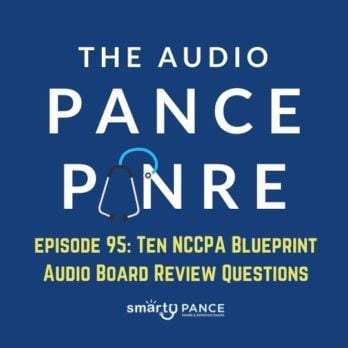Podcast Episode 95: Ten PANCE, PANRE, and Rotation Review Questions
Description
Welcome to episode 95 of the Audio PANCE and PANRE Physician Assistant/Associate Board Review Podcast.
Join me as I cover ten PANCE, PANRE and EOR review questions from the Smarty PANCE Instagram/Facebook page and the smartypance.com board review website.
Special from today’s episode:
- Follow Smarty PANCE and The Daily PANCE Blueprint on Instagram
- Follow Smarty PANCE and The Daily PANCE Blueprint on Facebook
Below you will find an interactive exam to complement today’s podcast.
The Audio PANCE/PANRE and EOR PA Board Review Podcast
I hope you enjoy this free audio component to the examination portion of this site. The full board review course includes over 2,000 interactive board review questions and is available to all members of Smarty PANCE.
- You can download and listen to past FREE episodes here, on iTunes, Spotify, on Google Podcasts, Stitcher, and most podcasting apps.
- You can listen to the latest episode, take an interactive quiz, and download more resources below.
Listen Carefully Then Take the Practice Exam
If you can’t see the audio player, click here to listen to the full episode.
Podcast Episode 95: Ten PANCE/PANRE and EOR Topic Blueprint Questions
1. A 52-year-old patient is admitted with a lower gastrointestinal bleed. He is given 2 units of packed red blood cells. A few hours later the patient develops a fever but has no other symptoms or changes in vital signs. Lab studies reveal no significant changes. Which of the following is the most likely diagnosis?
A. Transfusion-associated circulatory overload
B. Acute immune-mediated hemolytic reaction
C. Transfusion-related acute lung injury
D. Febrile non-hemolytic transfusion reaction
E. None of the above
The answer is D. Febrile non-hemolytic transfusion reaction
The most common transfusion reaction is a febrile non-hemolytic transfusion reaction (FNHTR).
Patients with FNHTR may present with a fever a few hours after receiving packed red blood cells (PRBCs), which is caused by the small number of white blood cells and cytokines that can be found in each unit of PRBCs. Treatment consists of giving acetaminophen and ruling out other causes of fever (e.g., central line infection, urinary tract infection, etc).
Incorrect Answers:
Transfusion-associated circulatory overload (Choice A) occurs when the volume of the transfused component causes hypervolemia.
Acute immune-mediated hemolytic reaction (Choice B) occurs when there are antibodies presented to blood donor antigens. Patients may present with hypotension, fever, or coagulopathic lab abnormalities.
Transfusion-related acute lung injury (Choice C) is due to antibodies reacting with antigens leading to the release of mediators that causes edema in the lungs. Symptoms include fever, hypoxia, and dyspnea.
Smarty PANCE Content Blueprint Review:
Covered under ⇒ PANCE Blueprint Hematology ⇒ Immunologic disorders ⇒ Transfusion reaction
2. Which of the following is not a side effect of lithium?
A. Hyperparathyroidism
B. Hypothyroidism
C. Cognitive fog
D. Tremors
E. All are side effects
The answer is E. All are side effects
Lithium is the first-line treatment for bipolar disorder. It has many side effects that you should remember, such as hypothyroidism, hyperparathyroidism, nephrogenic diabetes insipidus, cognitive fog, and tremors. Lithium levels should be monitored to avoid toxicity.
Remember, bipolar disorder is characterized by the symptoms DIG FAST: Distractibility, Irritability, Grandiosity, Flight of ideas, Activity increased, Sleep deficits, and Talkativeness.
Smarty PANCE Content Blueprint Review:
Covered under ⇒ PANCE Blueprint Psychiatry ⇒ Bipolar and related disorder
- Also covered as part of the Emergency Medicine EOR, Psychiatry EOR, and Family Medicine PAEA EOR topic list
3. Which of the following best explains the pathophysiology of vasovagal syncope?
A. Increase in parasympathetic signals and withdrawal of sympathetic signals
B. Severe narrowing of the aortic valve
C. Drop in blood pressure upon standing due to inadequate peripheral vasoconstriction
D. Occlusion of the pulmonary artery leading to right ventricle dysfunction
E. Blood accumulation in the brain leading to compression of adjacent brain structures
The answer is A. Increase in parasympathetic signals and withdrawal of sympathetic signals
Vasovagal syncope is the most common cause of syncope. Syncope is essentially transient loss of consciousness due to the lack of cerebral perfusion. Vasovagal syncope is usually triggered by something, such as emotion or stress.
A leading hypothesis of vasovagal syncope is that it is due to an increase in parasympathetic signals and withdrawal of sympathetic nervous signals.
Incorrect Answers:
A drop in blood pressure upon standing due to inadequate vasoconstriction describes neurogenic orthostatic hypotension (Choice C).
Occlusion of the pulmonary artery leading to RV dysfunction is describing a pulmonary embolism, which can lead to syncope (Choice D).
Blood accumulation in the brain leading to compression of brain structures is describing an intracranial hemorrhage (Choice E), which is a (rare) cause of syncope.
Narrowing of the aortic valve aka aortic stenosis (Choice B) can lead to syncope, but again, this is not vasovagal syncope.
<a cl








